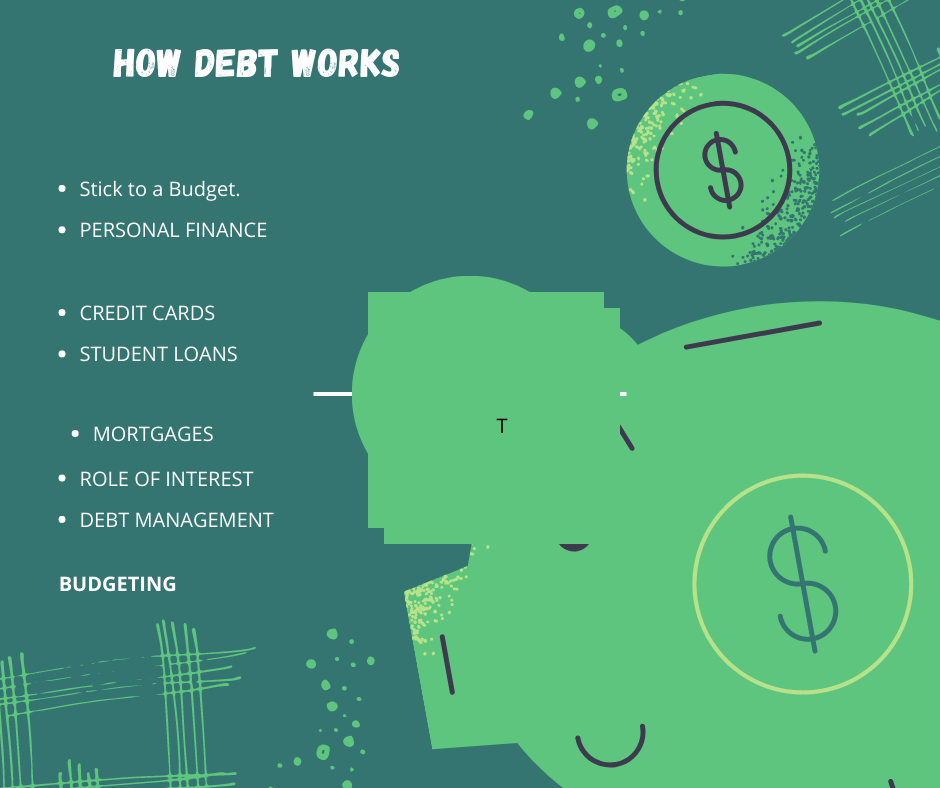Decoding the Mechanics:

Understanding How Debt Works
Introduction: In our modern society, debt has become an inescapable part of our financial ecosystem. Its intricacies can be overwhelming, leaving many feeling perplexed and trapped. In this article, we’ll embark on a journey to demystify the mechanics of debt, uncovering its inner workings and shedding light on the complexities that underlie this financial concept.
- The Basics: Borrowing and Lending: At its core, debt revolves around the fundamental dynamics of borrowing and lending. When individuals or entities require funds beyond their current means, they can seek assistance from lenders who provide monetary resources in exchange for the promise of repayment. This arrangement typically involves an added cost in the form of interest, which serves as compensation for the lender’s risk and the opportunity cost of deploying their capital.
- Types of Debt Instruments: Debt takes various forms, each with its distinct features and implications. Let’s explore some of the most common debt instruments:
a) Credit Cards: Credit cards provide users with a revolving line of credit, allowing them to make purchases up to a predefined limit. The outstanding balance incurs interest charges if not paid in full by the due date, making responsible credit card management crucial.
b) Loans: Loans encompass a wide array of borrowing arrangements. Personal loans, auto loans, and business loans are examples of fixed-term loans that require regular payments over a specified period. The interest rates and terms associated with loans may vary based on factors such as creditworthiness, collateral, and market conditions.
c) Mortgages: Mortgages are long-term loans specifically designed to finance the purchase of real estate. These loans are typically repaid over many years and are secured by the property itself. The interest rates on mortgages can vary depending on factors such as the borrower’s creditworthiness and prevailing market rates.
d) Student Loans: Student loans enable individuals to finance their education expenses. These loans often come with different repayment options and interest rates, and they play a crucial role in making higher education accessible to a broader population.
- The Role of Interest: Interest acts as a critical component of the debt landscape, reflecting the cost of borrowing money. Lenders charge interest to compensate for the risks they assume and the opportunity cost of deploying their funds elsewhere. Interest rates can vary based on factors such as creditworthiness, market conditions, and the duration of the borrowing period. Understanding the implications of interest rates is essential for borrowers, as they directly affect the total cost of debt and the monthly repayment burden.
- Repayment and Amortization: Repaying debt typically involves regular installments over a specified period. The structure of these payments can vary depending on the debt instrument. For example, mortgage payments are often amortized, meaning that each payment covers both interest and a portion of the principal. As time passes, the proportion of the payment dedicated to principal gradually increases, accelerating the debt’s repayment.
- Debt Management Strategies: Effectively managing debt is crucial for achieving financial well-being. Here are some strategies to consider:
a) Budgeting: Developing a comprehensive budget allows you to allocate your income effectively, ensuring that debt payments are prioritized alongside essential expenses.
b) Snowball or Avalanche Method: The snowball method involves paying off debts starting with the smallest balance, while the avalanche method focuses on repaying debts with the highest interest rates first. Choose the approach that best aligns with your financial goals and preferences.
c) Negotiating Interest Rates: In certain cases, it may be possible to negotiate lower interest rates on existing debts. Contacting creditors and explaining your situation can potentially lead to more favorable terms.
d) Seeking Professional Guidance: If debt feels overwhelming, seeking guidance from financial advisors or credit counseling agencies can provide personalized strategies and assistance.
Conclusion: Debt, with its labyrinthine mechanisms, plays a significant role in our financial lives. Understanding how it works empowers individuals to make informed decisions, navigate borrowing options wisely, and effectively manage their financial obligations. By embracing knowledge and employing smart debt management strategies, we can forge a path toward financial freedom and build a more secure future. Remember, with the right tools and mindset, the complexities of debt can be conquered, paving the way for a brighter financial journey.
